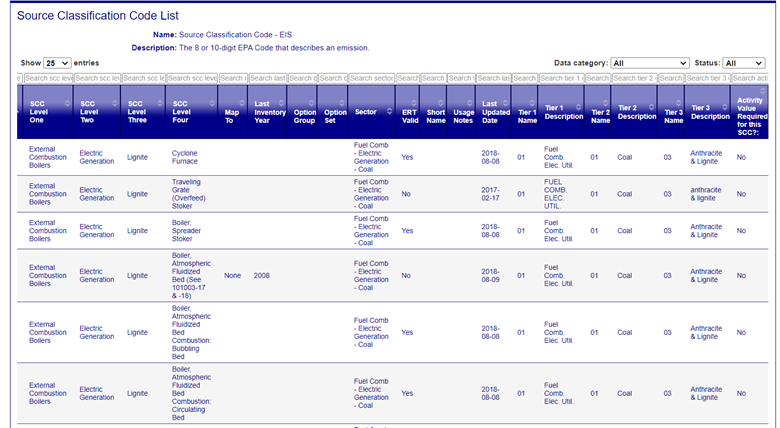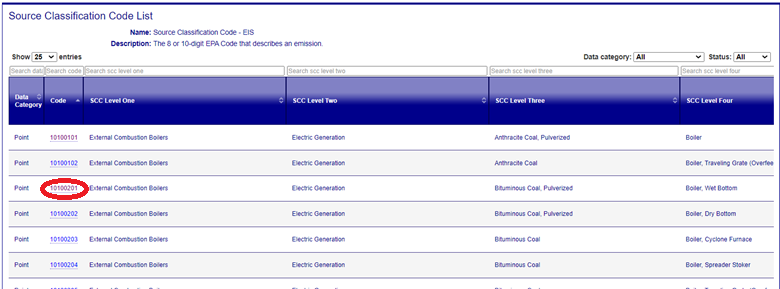Source Classification Code
Source Classification Codes
Users may view a list of all the current Source Classification Codes available for use in the Emissions Inventory System by accessing from the Reporting Code menu on the EIS navigation menu under Reference Data.

Select the Source Classification Code link from the Reporting Code Tables list to navigate to the Source Classification Codes table.


Source Classification Code List
The Source Classification Codes are eight or ten-digit codes that the EPA uses to classify different types of activities that generate emissions. An SCC represents a unique source category-specific process or function that emits air pollutants. An SCC is used as a primary identifying data element in the National Emissions Inventory as well as other EPA, State, Local, and Tribal air quality systems and databases. The following are examples of processes described by SCCs and the emissions they may produce:
- Burning fuel in a boiler produces oxides of nitrogen (NOx) and other criteria and hazardous air pollutants.
- An industrial process, such as paint coating, produces volatile organic compounds (VOCs)
- Fire produces particulate matter (PM)
Within the Reporting Code table, Gateway users may access a list of all the Source Classification Codes (SCCs) available in the Emissions Inventory System. The Source Classification Codes are classified by data categories: Point, Nonpoint, Events, Nonroad, and Onroad sources. The Gateway Source Classification Code List on the Gateway provides a table of all active and retired SCCs listed by Data Category.


Definitions of the fields that are displayed in the data table are provided below:
| Column Name | Description |
|---|---|
| Data Category | Refers to whether the SCC source is Point, Nonpoint, Nonroad, Onroad, or Event. Some retired codes included a Biogenics data category, but these are now considered Nonpoint |
| Code | The 8 or 10-digit SCC code. |
| SCC Levels 1-4 | Hierarchical code-level descriptions of the processes. The level of detail increases as the SCC level increases. |
| Map To | Identifies the reporting code that should be used instead of the specified code. In some cases, a code is retired or modified, and a new code should be used in its place. This field shows which code should now be used. For example, SCC 10200210 was retired in 2008 and has a map to code of 10200205, which is the code that should now be used instead of 10200210. |
| Last Inventory Year | The last inventory year in which emissions data could be submitted using a code value. If the cell is empty, it means the code is still active. For example, if a cell contains "2002", then that code was used in 2002 but was no longer considered active in future year inventories. |
| Option Group | For internal EPA use. Refers to a group of SCCs that may overlap (parent and children SCCs). It is necessary to distinguish this group so that data that is infilled automatically within EIS is done correctly, without double-counting, during the selection generation process. See option set. |
| Option Set | For internal EPA use. Refers to the hierarchy of SCCs within an option group. The hierarchy is defined with an alphabetical listing of values. All records with the same option set code belong to the same “level” of the hierarchy. When a selection is performed, only SCCs of the same level of a selected record will be included for a given pollutant in the resulting selection. |
| Sector | Sectors can be used to summarize emissions, allocating emissions to different categories with multi-pollutant inventories in mind, and are especially helpful for summarizing combinations of CAPs (criteria air pollutants) and HAPs (hazardous air pollutants). The EIS Sectors can also be further aggregated to provide custom summaries. |
| ERT Valid | Refers to use in the Electronic Reporting Tool (ERT). This field is currently being used to identify which SCCs are used by SPPD for their regulatory purposes. |
| Usage Notes | Details of how to use an SCC, where applicable. |
| Last Updated Date | Refers to the date when this code was last updated in some way. For example, code 10500102 has a last inventory year of 2008, effectively retiring this code for 2011 and 2014 inventories. |
| Tier 1-3 Name | For internal EPA use. These are numerical codes associated with Tier 1-3 descriptions. They are helpful when compiling emissions data by tier descriptions. |
| Tier 1-3 Descriptions | For internal EPA use. These are high-level categories of SCCs used to summarize CAP emissions trends in EPA documents. Tier 1 is the most general, and Tier 3 is the most detailed. These categories are broader than level descriptions. While they were created for EPA use, some SLTs find this way of grouping SCCs helpful. |
| Activity Value Required: | For internal EPA use. |
Source Classification Code Information
Clicking on the SCC in the data table will take you to the Source Classification Information page for that SCC record.

There are two tabs, SCC Detail and Acceptable Emissions Range, that you may select.

The page defaults to the SCC Detail tab, displaying the details for the particular SCC with all the same fields listed as in the Source Classification Code List table.

Acceptable Emission Range
Clicking on the Acceptable Emissions Range displays the pollutant codes, pollutant descriptions, and the QA threshold values for each pollutant for that SCC.
